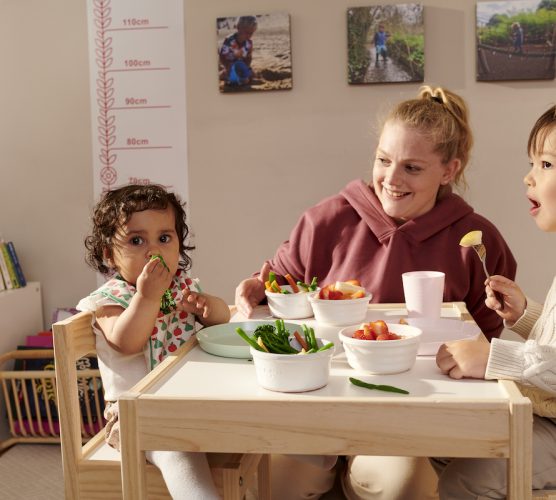Food and children: what do they make you think of first? Health, using your senses, or perhaps just enjoyment and a full tummy? Preparing safe, nutritious, and yummy food for children is important for childminders, so taking a course is a really good idea. A well-designed food hygiene course will cover how to prepare and store food safely, clean your cooking equipment, think about food allergies, keep a record and much more.
What will I learn in a food hygiene course for childminders?
It really depends on the provider and how in-depth their training is. On top of teaching good hygiene, a course can include everything from preparation, storage, and shopping for affordable, healthy food, to record-keeping, meal-plans, recipes, diets and allergens.
If you choose to become a childminder with Koru Kids, we cover basic and advanced food hygiene in our training for childminders. We also go through meal plans, nutrition, food and learning, weaning, and smart shopping.
But if you only need the food hygiene basics, a good course will cover these four key areas of food preparation.
How to safely heat food to the correct temperature
Little children need food to be cool enough so they don’t burn their mouths, but before it gets to that stage it needs to be heated properly. If it’s not something that can be eaten raw safely, or doesn’t need heating (like a piece of bread with cream-cheese) you need to know what temperature will kill those nasty germs. The course should teach you how to store certain foods at correct temperatures, too.
How to safely prepare milk and clean equipment
Chances are at least one of the children in your home nursery will be young enough to drink milk often. If they’re around 6 months old, it will be their main food source. It’s also important for children to get enough calcium in their diet for growing bones–dairy is a good way to do that.
Unfortunately, milk is all too happy to grow bacteria. Whether it’s formula, breastmilk, or cow’s milk, you need to know how to prepare it safely, and how to sterilise bottles and other equipment.
Your own hygiene will be covered, too. We’re all hyper-aware of germs right now, but food hygiene is about all kinds of germs—not just COVID-19. Most of the training will be obvious (wash your hands, don’t sneeze or cough on the food), but there could be things you haven’t thought about that will make you a safer chef. That means one less hazard in your home setting.
How you can support healthy lifestyles
Food is more than just fuel to keep children going: it also needs to contain the right nutrients for healthy bodies and minds. A good food hygiene course for childminders teaches you what you should include in a meal, and what you should leave out.
As a general rule, it will tell you about the main food groups—different carbs, proteins and fats, fruits and veggies for little tummies. You’ll also learn why you should avoid ‘processed foods’ (think hotdogs, crisps, and microwave meals), high in salt and saturated fats. If it sounds complex, just remember that home-cooked is always best, and that green is good.
Beyond the food hygiene course, training for childminders should include how you serve the meals, when, how much, and why. It goes through snacks and meals, what drinks to offer and which to stay away from, times of day, and how to deal with mealtimes in a practical way.
How you identify the main allergens in food
An ‘allergen’ is something that can make a child really ill, though it won’t affect every child. It’s important that you always find out, and keep track of, any allergies of children joining your home nursery. Nuts are well-known allergens and should be kept out of a childminder’s home, but there are many other foods that can cause a bad reaction.
A first aid course will teach you what to do if a child experiences anaphylactic shock (also called ‘anaphylaxis’: a really bad allergic reaction to food or other allergens), but a good food hygiene course will teach you how to prevent this in the first place. Though milk is great for many, it’s not nice if you are a lactose-intolerant baby!
What’s the best food hygiene course?
There are plenty of food hygiene courses around, but the problem is figuring out which one is best for childminders. It can be hard to find out everything the course will cover until you have paid for it.
Ofsted are not clear on what type of food hygiene training you will need. It’s actually not part of their requirements to take a course, as long as you can demonstrate the right knowledge. This makes it hard to figure out what’s worth your money and time. Costs can range from £20–£200, and it’s only during your Ofsted registration visit you find out if you know enough… or if it means you fail inspection.
Why do I need a food hygiene course?
It can seem pretty obvious to some, but you might feel that you don’t need one. If you have raised your own children it might seem unnecessary, but new discoveries often reveal that what we once thought was safe for children isn’t. There are several good reasons to take a food hygiene course specifically created for childminders.
Short-term safety, long-term health
Most parents will care a lot about what their children are eating, and not eating. When you have learnt the basic food hygiene facts, ask parents what they expect to see in their children’s diets. Support them in the—almost—inevitable battle of the ‘picky eater years’. Taking a food hygiene course will also be a great business decision: parents are always happier when they know you have had professional training.
Children don’t just stop existing once they leave your home nursery and move on to school and adulthood. They really don’t! Everything you do matters: when you feed children the right stuff, it gives them the best shot at growing up healthy, with great eating habits and a love of food and cooking to boot.
Food is more than fuel
Every mealtime is a fun chance to learn. Eating as a ‘family’ around a table creates a lovely sense of togetherness. And, it gives smaller babies and toddlers the chance to watch how you and older children eat.
Food can create amazing colours and shapes, or countable pieces on a plate. It also involves all of our senses: vision, smell, taste, touch, and even hearing when you are slurping soup, crunching into a carrot, or breaking a crusty loaf in two.
Wherever you get your food hygiene course from, it should give you the tools to become a safer, wiser, more confident childminder—using your meals and snacks as another way to strengthen the bodies and brains of the little people you look after.



